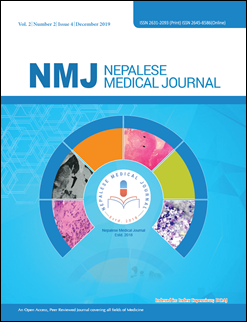Outcomes of Retrograde Intra-Renal Surgery
DOI:
https://doi.org/10.3126/nmj.v2i2.26478Keywords:
Flexible ureteroscopy, Holmium laser, Renal calculusAbstract
Introduction: Miniaturization of endoscopic instruments has gained wide popularity in the treatment of renal calculi. Retrograde intra-renal surgery and holmium laser in combination has already proven its superiority when compared to other modalities in the treatment of renal calculi. This study was conducted to assess the outcome of retrograde intra-renal surgery in renal stone disease.
Materials and Methods: This retrospective study analyzed the outcome of retrograde intra-renal surgery in renal stone less than 2 cm size in the adults above 18 years of age from September 2018 to August 2019 at Patan Hospital, Nepal. The outcome was assessed descriptively on postoperative pain and fever, stone localization, stone size, stone clearance, urosepsis, operative time, hospital stay, mortality, need of the second procedure.
Results: A total of 62 patients underwent retrograde intrarenal surgery, out of which 48 cases were included. The mean age of the study population was 32.4± 14 years (19-68 years). Similarly, the mean operative time was 68± 12 (48-124 minutes) and mean hospital-stay was 3.2± 1.1 days. Postoperative pain and fever were observed in 14 (29.16%) & 4(8.33%) patients respectively. Hematuria occurred in 6(12.50%) and urosepsis in 2(4.16%) of the patients. Complete stone clearance was achieved in 34(70.83%) and residual stones were present in 8(16.66%) and clinically insignificant radiological fragments were present in 6(12.50%) patients.
Conclusions: Retrograde intrarenal surgery is a technically safe and effective procedure for the treatment of renal calculi, with minimal post-surgical morbidity.
Downloads
Downloads
Published
How to Cite
Issue
Section
License
This license enables reusers to distribute, remix, adapt, and build upon the material in any medium or format, so long as attribution is given to the creator. The license allows for commercial use.
Copyright on any article published by Nepalese Medical Journal is retained by the author(s).
Authors grant Nepalese Medical Journal a license to publish the article and identify itself as the original publisher.
Authors also grant any third party the right to use the article freely as long as its integrity is maintained and its original authors, citation details and publisher are identified.




